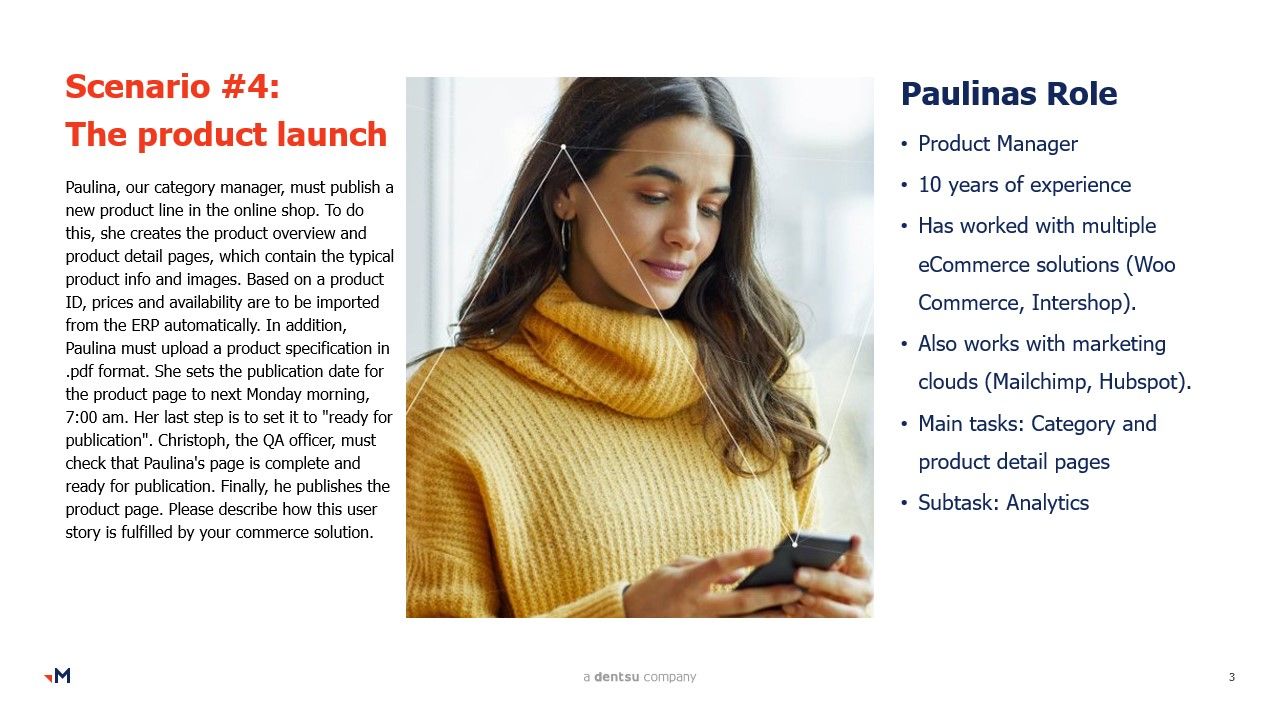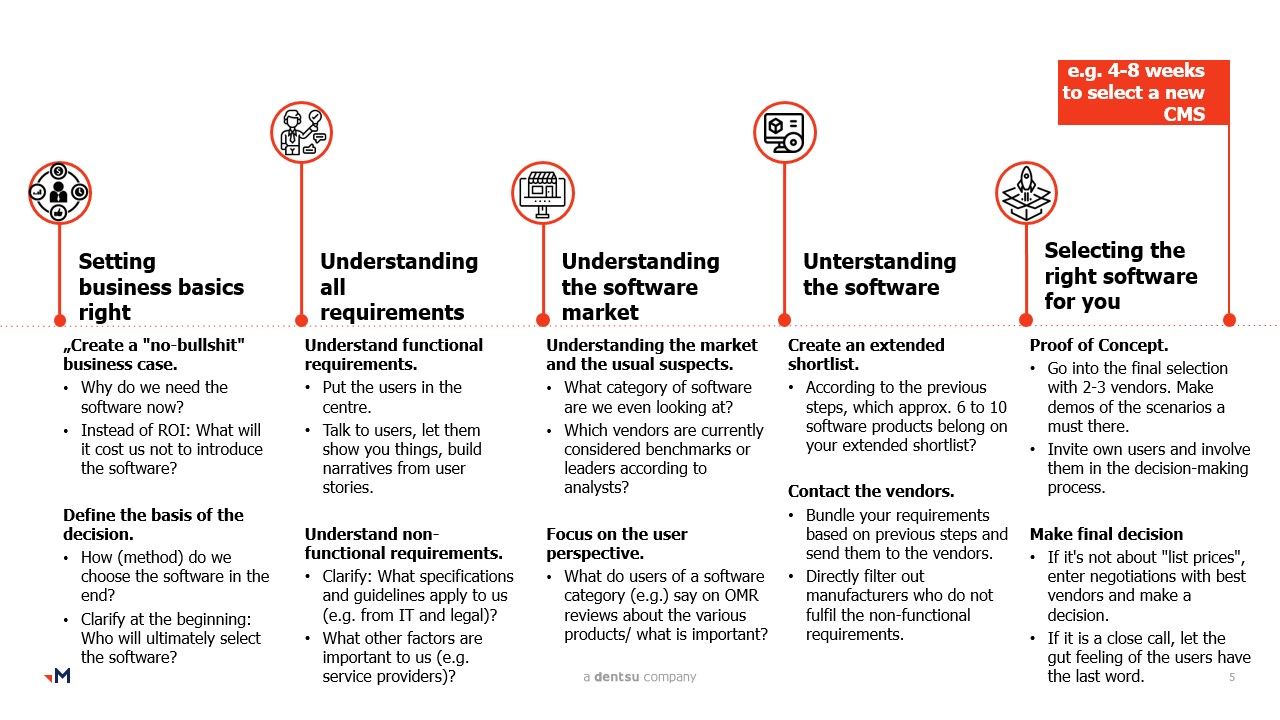The right way to choose the right software for your business
Learn what is the right approach to software selection for enterprises and what mistakes to avoid in the process

How software is selected in enterprises.
We rewind 15 years. Into 2006. In a large enterprise. In the IT division. Workflow management systems are very much in vogue. Their promise: Automate any business process, without programming effort, but by configuration. The opinion is quickly formed: The enterprise needs this software, the advantages are too obvious. A first Excel calculation proofs: With 100 mapped processes, the software pays for itself in less than 3 years. Hence, the investment is approved. A person in charge is defined and a project team is formed. First step: Evaluating the best WMS. The research begins. What is available from SAP, IDS, Oracle, IBM and Microsoft? What does the competition use? What features do we absolutely need? Core functionalities are taken 1:1 as requirements: "Processes must be modelled using BPMN, we need release processes, versioning, ...". The requirements Excel sheet quickly reaches 100 lines. Business units that are supposed to benefit from the new software are defined. HR makes sense. From vacation request processes to the staff's uniform orders in the production department, there are many processes that should be automated anyhow. The software is put out for tender. Leading software vendors bid and demonstrate the strengths of their software. The committee of IT management and project team decides, and a software is selected. The software is bought, installed on-prem and a service contract is signed. The project begins. Soon, new challenges are encountered. Production workers have neither a company email addresses nor computer access. So, the workwear ordering process cannot be completely automated, and even holiday requests can only be implemented for the office staff. Above all, there is a lack of an intuitive user interface with forms, because the software mainly covers the process side. The project is delayed and will be restarted later. Using the ordering process for new hardware, the software finally goes live. A larger rollout fails afterwards. The project is terminated, and the software is transferred to line responsibility in IT.
Such a process is not an exception. For years, and even today, companies have been selecting software in this way, or something similar. My criticism is not directed at an individual aspect in the example, but at the bigger picture behind, the process of software selection. The clumsy question is: "Do we have to do it this way?" and consequently: "Can't we do it better, somehow more modern?" or quite fundamentally: "How do we select software for our business in 2021?"
What could possibly go wrong?
I must admit that as a management consultant or service provider one is tempted to make a science out of the topic of software evaluation to secure one's own business first. But this usually does not make sense for the client. Whether you approach a software selection correctly or are prone to the typical pitfalls can be tested by looking at 5 simple examples. Tony Byrne, founder of the Realstorygroup, a marketing software analyst from the US, summarised the 5 pathologies of software selection as follows (1):
- "Handy incumbent": Software is selected because one already licensed it for something else.
- "Horse race": Software is selected because an analyst or guru has placed it on a quadrant at the top right.
- "Puppy love": Software is selected because one fell in love with it after seeing a demo.
- "Cousin Vinny": Software is selected because other companies in one's industry recommended it.
- "Checklist Fetish": Software is selected because it came out as a winner of a 200-line requirements Excel exercise.
So? Did you see yourself caught out? The checklist fetish is seen as the worst because it suggests scientific correctness, but usually has little significance. Or would you follow if your consultant told you: "Content Management System A got 94.5% of the points and System B only 88.7%. So, we'll clearly take A." The question is: if all this doesn't make much sense, then "How should you choose (the right) software properly today?"
First of all, the usual disclaimer: A universal answer is not possible, or advisable. Software types, company sizes and business context are too different. This means that an ERP is selected differently than software for newsletter marketing, or listed companies are bound by different guidelines than start-ups, and software used in core processes such as order management must be evaluated completely differently if a company is currently pursuing a D2C strategy. However, the unifying and probably decisive success factor in software selection is - oh wonder - the users.
Putting software-users on centre stage.
Software is selected for users and their "user stories" should be covered as comprehensively as possible. After implementation at the latest, this leads to increased acceptance of the software, consequently to its use and thus to success. As described, however, Excel spreadsheets still widely dominate the software selection process. So how do you get the software users to take centre stage?
Our recommendation is to first separate into 2 dimensions clearly:
- Functional requirements describe all functions of a software that users will users will later use directly.
- Non-functional requirements define the operational context and boundaries of the software. This includes topics such as security, operations, costs, scalability, the long-term strategy of the software vendor, support by service providers, etc.
For functional requirements in particular, so-called user stories have become established in line with the agile philosophy. For example, nowadays one no longer writes:
- " Approval workflows are a MUST", but rather
- "I, as a marketing manager, would like to be able to adapt an approval workflow myself, so that we can react flexibly to the different publishing processes in corporate communication."
In this way, the pure "feature request" is expanded to include the user, her context, and a rationale. But regardless of whether it's an Excel list or user stories: when companies ultimately send their requests to software vendors, the result is often monotonously tacit: "Yes", "fully met", or "out of the box" is the answer most of the time. And you can't blame the software vendors for this. After all, they only answer the tender. At Merkle, we therefore always recommend that our customers combine user stories into longer narratives, and then ask the question: "How does the software help us to achieve this scenario?" An example from the field of ecommerce and digital marketing shows this clearly.

The illustrated scenario of the product launch cannot be answered with a simple "yes", but with a customer-oriented demo. The evaluation of the demo should also be carried out with the involvement of the users, in this case at least Paulina and Christoph. By means of simple scoring mechanisms, e.g. a 5-star scale, the best result can be achieved in our opinion.
Non-functional requirements should be understood mainly as "scope and boundaries". This means they are (at best) all to be taken as mandatory requirements, define the context and limits, and cannot be assessed again from different sides. From the ISO standard that must be fulfilled, to a maximum annual price for service and operations, over security requirements, until barrier-free accessibility: non-functional requirements can be elicited in advance through workshops with the right user and stakeholder groups. Usually this includes IT, business and legal. Here, you are welcome to use the popular Excel for the documentation.
Seeing the wood for the trees.
However, one crucial aspect is still missing in the modern software selection process. How do we know whether we are looking for the right type of software after all? In the domain of digital business, the technology super map from Chiefmartech.com (2) has been used for almost 10 years to show the variety of possible software. This, as well as the relevant reports by the analysts of Gartner and Forrster (3) quickly provide an initial assessment of whether one is looking in the right software category. However, the boundaries between software are becoming increasingly blurry. eCommerce solutions offer the possibilities of a CMS, CMS those of a DAM, DAMs those of an IAM solution, all of them also describe themselves as DXP, and so on. So, to get down to the appropriate extended shortlist of the right software, you often must do a lot of research.
A silver bullet for this research is the OMR Reviews platform recently launched by OMR, a German based Digital Marketing Hub (4). Here, the focus is on software users, who openly and directly evaluate what they like and where they see potential for improvement withing all kinds of software. Reviews of Microsoft teams are on the platform, but for instance also of the SAP Commerce Cloud or Software for financial planning or business intelligence. The map of Chiefmartech is reflected here, but including the evaluations from users. We at Merkle are pleased to be able to work together with OMR here and have also been diligently evaluating software since this summer, especially software that we ourselves know very well as users, e.g. when we work for customers in conversion optimisation or in design processes for digital products with our customers.
5 Simple steps to select the right software for your business
It is now time to draw a conclusion from the points discussed. So how does one select (the right) software properly in 2021? A summarising guiding principle here is: "Good software selection processes are similar to good software development processes". Since one could take a wrong turn here, let me clarify once again: In good software development processes, the future users are at the centre. Through various projects in which we were privileged to support clients in software selection, we recommend a 5-step model in which you will find your direct guiding questions and tasks for each step. This summarises the most important points mentioned in a short form and hopefully serves you as a checklist for your next software selection.

The advertising block at the end: As you hopefully know, Merkle can support you not only in software selection, but in the complete digital value chain. From digital strategy, data strategy, conception and design, to software configuration, integration and implementation: don't hesitate to contact us if you need support. My colleagues and I look forward to your enquiries.
Quellen:




